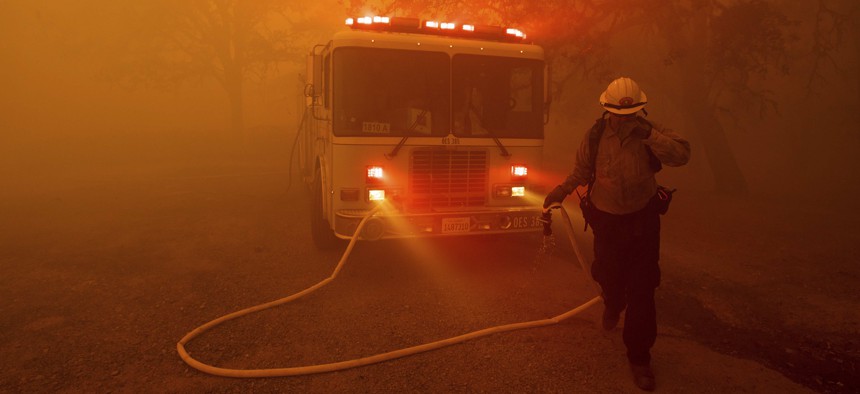Ensuring That Disaster Planning Considers People With Disabilities

A firefighter rushes to save a home as the River Fire tears through Lakeport, Calif., on Tuesday, July 31, 2018. AP Photo/Noah Berger, File

Connecting state and local government leaders
A California state official describes a “cultural shift” he’s seen in recent years.
There was a time when California’s state emergency plan had a one to two page section that specifically focused on issues related to people with disabilities and others who have “access and functional needs.”
“It was in the middle of the plan,” L. Vance Taylor, chief of the state’s Office of Access and Functional Needs, said at a recent event Route Fifty held in Sacramento.
The state plan serves as a blueprint of sorts for local governments putting together their own emergency management plans for natural disasters and other events.
Taylor, who uses a wheelchair himself, said that a problem with having a discreet section devoted to access and functional needs is that people involved in planning and response efforts would often go to the part of the document that was related to their own work.
“If you’re in logistics, you go to that section of the plan. If you’re in response, that’s where you go,” he said. “Nobody ever got to the access and functional needs part.”
So, in a rewrite, the state removed the separate section and incorporated the materials in it throughout the rest of the document.
Not so it monopolized the plan, Taylor explained, but so that anyone working with the plan would understand how to consider access and functional needs in the work they do.
The result, according to Taylor, has been that things like interpreters at press conferences, accessible transportation for evacuations, and “wraparound” services at shelters are no longer thought of “extra or special” accommodations. “It’s just simply what we do,” he said.
Access and functional needs is a broad term. It not only covers people with disabilities, but also the elderly, children, people who speak English as a second language, and those with limited transportation options, all of whom can be especially vulnerable during emergencies.
Taylor offered the state emergency plan revisions as an example when asked about how his field has changed in recent years. Overall, he described a “cultural shift” toward ingraining best practices around access and functional needs into emergency planning and response.
He said by phone prior to last week’s event that some people with disabilities, if they aren’t confident that amenities allowing them to live independently and without difficulty will be available at shelters, can be reluctant to evacuate from their homes when disasters occur.
For state and local officials, taking this into consideration may mean ensuring that there are accessible showers, toilets, hand washing stations, cots and other provisions on hand.
Chief Thom Porter, who is director of the California Department of Forestry and Fire Protection, the state’s lead agency for dealing with wildfires, also spoke at the Sacramento event.
He pointed out that certain outlying communities facing wildfire risks have aging populations, and that in some cases families may only have one car that someone drives to work, meaning it is not always available for other family members to escape a fire threat.
“The ability for people to move quickly out of areas is not necessarily at their fingertips,” he said.
Residential growth in areas where there are wildfires, more extreme fires, and the loss of communication systems when the blazes happen can complicate matters further.
Taylor emphasized that people often approach emergency planning and response, as well as other situations, with their own experiences in mind. “That's what guides us,” he said.
“If your experience has nothing to do with ramps or accessibility,” he added, “then sometimes good people who are trying to do good things simply don't know what they don't know.”
Bill Lucia is a Senior Reporter for Route Fifty and is based in Olympia, Washington.

NEXT STORY: The States Where the Most New Homes Are at Risk of Flooding





